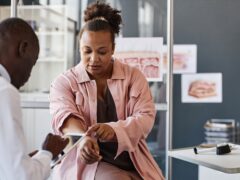Everyone who goes outside is exposed to the sun. It is important to know the effects of sun exposure.
The American Academy of Family Physicians (AAFP) advises talking to children, teens, and young adults with fair skin about the dangers of too much sun exposure. You should teach them how to protect themselves and reduce their risk of skin cancer.
There is not enough research to recommend screening for skin cancer. This does not mean it isn’t a good form of prevention. Talk to your doctor about screening if you are at risk of skin cancer. You also can check yourself and your kids at home.
What is sun exposure?
The sun gives off rays of light that can help and harm us. These are known as ultraviolet (UV) rays. There are three different types of UV rays: UVA, UVB, and UVC.
UVA rays are the most common form of sun exposure. UVB rays make up less sun exposure but are more intense. UVC rays are the worst. Luckily, we are not at risk of UVC rays. The earth’s ozone layer blocks these rays.
Even though you can’t see UV rays, they can go through your skin. The outer layer of skin is the epidermis. The inner layer is called the dermis. Your nerves and blood vessels are located in the dermis. Epidermis cells contain a pigment (or dye) called melanin. People with light skin have less melanin than dark-skinned people. This is why very fair-skinned people burn easier.
Melanin protects our skin and also creates vitamin D. When your body defends itself against UV rays, your skin tans or darkens. Too much sun exposure allows UV rays to reach your inner skin layers. You know this as sunburn. This can cause skin cells to die, damage, or develop cancer. Signs of sunburn include:
- Redness. Your skin will turn red due to an increase in blood flow. It can happen right away or over time. You might not know you are burnt until you go back inside.
- Hot skin. You also can get goose bumps or chills.
- Pain.
- Itchy or tight skin.
- Blisters.
- Dehydration.
- Peeling. This is your body’s way of shedding the dead cells.
Why is sun exposure important?
There are benefits and risks of sun exposure.
A small amount of UV rays is good for us. It creates vitamin D, which absorbs calcium. Your body needs calcium to build and maintain healthy bones. You also can get vitamin D from certain types of food. If you have low vitamin D, your doctor might suggest taking a supplement.
According to the World Health Organization (WHO), UV rays can help treat some health conditions. Doctors might order it for people who have eczema, psoriasis, rickets, or jaundice. UV rays also can be used to disinfect or sterilize.
Too much sun exposure can be harmful. It can lead to:
- Skin changes. Some skin cells with melanin can form a clump. This creates freckles and moles. Over time, these can develop cancer.
- Early aging. Time spent in the sun makes your skin age faster than normal. Signs of this are wrinkled, tight, or leathery skin and dark spots.
- Lowered immune system. White blood cells work to protect your body. When your skin gets burnt, white blood cells help create new cells. Doing this can put your immune system at risk in other areas.
- Eye injuries. UV rays can damage the tissue in your eyes. They can burn your outer layer called the cornea. They also can blur your vision. Over time, you can develop cataracts. This can cause blindness if left untreated.
- Skin cancer. Most skin cancer is not melanoma. It is very common, but also very treatable. Melanoma skin cancer is not as common but is more severe. Skin cancer can spread to other areas in your body, especially if left untreated.
Everyone is at risk of the effects of sun exposure. It doesn’t matter how old you are or what color your skin is. Your risk increases based on the length and depth of exposure. You are at greater risk if you have fair skin or moles. Family history of skin cancer also is a factor. People who work in the sun all day are at greater risk as well. Farmers, construction workers, and fishermen need extra protection.
Path to improved health
You can prevent the harmful effects of sun exposure. Get to know your body and how it reacts to sun. Follow these proven guidelines recommended by the U.S. Food and Drug Administration (FDA).
- Use sunscreen. The higher the SPF, the more it will protect against UV rays. The FDA suggests using SPF 15 or greater. Broad-exposure sunscreen blocks out both UVA and UVB. You should apply sunscreen 30 minutes before going outside. Remember to apply overlooked areas, like your ears, lips, and hairline. You should reapply sunscreen every 2 hours. You also should reapply after swimming or sweating.
- Plan your exposure. Avoid direct sun between 10 a.m. and 4 p.m. This is when the sun’s rays are strongest. Be careful in locations that are closer to the equator.
- Take breaks. Too much sun exposure is harmful. Go inside, get in the shade, or use an umbrella.
- Cover up. Wear clothing and hats to protect your skin from UV rays. This should always apply to babies and kids, who are more sensitive. You also should wear sunglasses that block UV rays.
There are other factors to keep in mind in regard to sun exposure. Some medicines can make you more sensitive to the sun and its UV rays. These include antibiotics and birth control pills. Check with your doctor or the pharmacy for side effects.
UV rays reflect off certain surfaces, such as water, concrete, sand, and snow. You are more at risk in these areas. This means you can get sunburned while skiing. You also can get sunburned when it is cloudy outside.
You should never use tanning beds. Even though the light doesn’t come from the sun, doesn’t mean it’s safe. Tanning beds and sun lamps have high amounts of UV rays. You also should avoid using products that help you tan. Oils, lotions, and pills claim to produce more melanin and darken your skin faster. These products are not approved by the FDA.
Things to consider
There are safe ways to get a tan. You can use sunless self-tanners. Lotions, sprays, and tinted makeup provide color without risk of damage. You also can get an airbrush tan. It has become more common for salons to offer this service. Unlike the sun, though, “fake tans” do not create melanin. You still need to use sunscreen and other means of protection when you are exposed to the sun.
When to see your doctor
Ask your doctor if you should get regular screenings to look for early signs of cancer. These can help detect early signs of skin cancer. You also can check for new or changing skin spots at home. Contact your doctor if you notice anything unusual. This includes a spot that hurts, itches, or has changed color or shape.
Your doctor will perform an exam to look at your skin. They might need to remove part or all of the spot to take a biopsy. This will show if the spot contains cancer or not. Your doctor will work with you on treatment if they find cancer.
Questions to ask your doctor
- At what age should I start using sunscreen?
- How do I know what SPF sunscreen to use?
- How much sun exposure is considered healthy?
- How do I know if a skin spot, like a mole, is abnormal?
ADVERTISEMENT
ADVERTISEMENT




